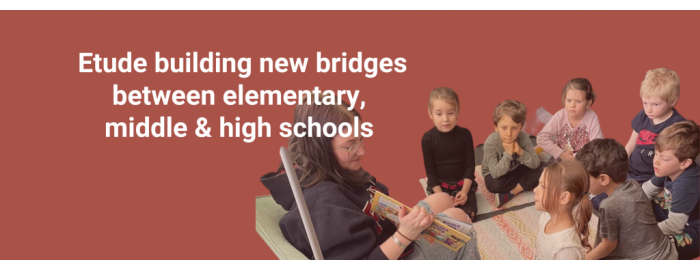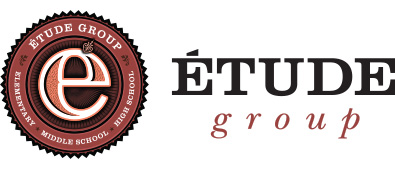
Usually, when a student moves from fifth grade to middle school, she kicks the dust of that elementary school off her feet and never looks back. The same thing happens again when she moves from eighth grade to high school.
That’s the typical system, but that’s not the way it works for Etude Group. At least, that’s not the way it’s supposed to work.
Founding director Ted Hamm is working on ways to get students at each level to interact more with each other and help one another carry the concepts that begin for them in kindergarten straight through to commencement.
“The intent of the network from day one has been to be K-12,” he said. “To create the same educational flow throughout all three levels.”
It was always meant to be that way, but Covid forced the schools to retreat to virtual learning and pull back from the collaborations they’d established.
“We’d had plans to build more K-12 structures, but when Covid hit everybody went back into their own silos,” Hamm said. “Everybody was stuck in their own groups or in virtual; there were no opportunities to share learning across our network.”
Now that students are back in their classrooms together, the schools in the group have a renewed push to build those bridges to one another.
Why is this important?
Because the concepts Etude students begin learning in kindergarten – for instance, collaboration and communication – evolve as the students mature and develop organically into concepts such as self-discipline and habits of professionalism.
The result is that students graduate from Etude High School with a comprehensive education in important concepts they’ve been growing into throughout their entire school career.
This works best, however, when students stay with Etude schools from kindergarten all the way through 12th grade. Students who attend Etude Elementary School and then transfer to a more traditional school in middle school will find they’re starting over in some ways and not continuing the hands-on, experiential learning that dominated their earlier learning.
In contrast, kids who come into Etude schools in middle or high school have a different sort of adjustment to make.
“It's not a natural way for them to learn if they start in middle or high school,” Hamm said. “They sometimes struggle with the fact they have a voice and control of their learning; they’re not used to that. It takes them a year to settle in from the perspective of doing presentations of learning and having a choice within projects.”
That’s not to say students can’t benefit from Etude’s unique approach if they don’t remain with the school for all 13 years, Hamm said. They can, and do.
“I think one of the true advantages of an Etude education is the flexibility our school offers,” he said. “Kids can take leadership roles they might not have considered before. They can pursue their interests. It’s not a lockstep curriculum – it allows them to learn about themselves and their interests and pursue those interests.”
Creating stronger bonds between all three levels will extend to the group’s public presence as well, including its social media accounts.
Hamm said combining the schools’ distinct social media efforts into a unified platform will make it easier to showcase what the students are doing, how lessons and concepts flow from one level to another and where they lead.
Here’s an example: Etude’s second- and third-graders took a trip to Kohler-Andrae State Park to study how the glaciers impacted the formation of Lake Michigan. That lesson provides the foundation when, as high school students, they’ll study the effect of microplastics in the lake and build robots to monitor the presence of those materials.
“We want parents to see that kind of K-12 flow to the curriculum,” Hamm said.
Etude Group has invested a lot of energy in its experiential learning model, including work that’s supported by Harvard University’s Project Zero.
Making thinking visible, encouraging critical thinking and problem solving, getting students comfortable asking questions, “That’s the heart of learning,” Hamm said.
Teachers in all the schools are beginning to work together more, Hamm said, and the school’s culture of experiential learning and accountability continues to build.
“They’re finding opportunities for middle school and high school students to interact with elementary students in meaningful ways,” he said. “They’re looking for ways to bridge the gap between schools, so younger and older kids get used to seeing each other; for learning-focused ways for our kids to interact.”

